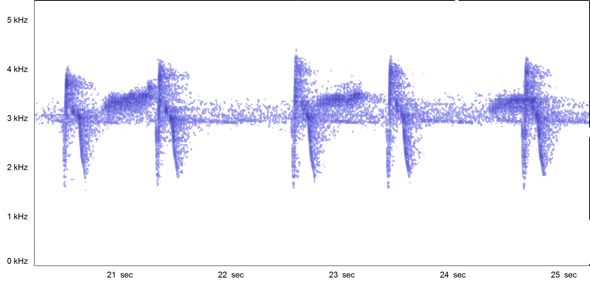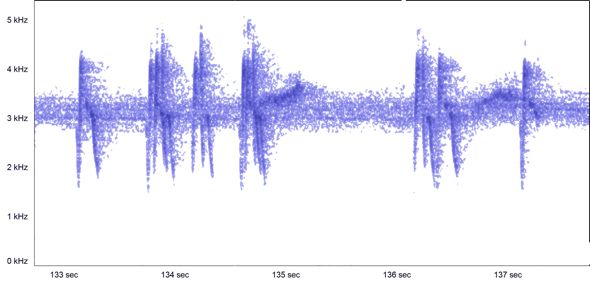“One sunny afternoon in early July 2011, a melodious duet by a pair of Ashy Tailorbirds (Orthotomus ruficeps) was heard at the back mangroves of Pasir Ris, Singapore. Both birds were hopping along from branch to branch as they were singing intimately to each other. A brief recording of this duet was made (2 min, 25 sec) and may be previewed here HERE. Towards the end of this recording (at the 2 min, 14 sec point), a scuffle ensued as another intruding male tailorbird appeared on the scene and this challenger was immediately and aggressively chased away.
“Upon careful analysis of the call composition of this duet, the more prominent male’s call may be described as the ‘rolling prii’u’ as indicated in Robson (2000: 436 – species 939). The subdued female’s call was comparable to the ‘spluttering trilled prrrrt’ (Robson, 2000: 436). From the sonogram generated, it may be seen that the male’s call has the shape of an inverted ‘V’, or a pair of forceps (above). Each male note typically lasts between 190–210 msec, ascending sharply from 1.6–4.1 kHz, then returning back to 1.6 kHz within this time frame. By contrast, the female note is longer and lasts between 440–450 msec. It rises gradually from 3.1–3.5 kHz, and appears as a rotund cigar or caterpillar on the sonogram.
“During the confrontation with the rival male, the closely spaced notes of both males may be seen as overlapping ‘forceps’ in the sonogram (above) – depicting the intense competition and vocal sparring in the heat of the moment. It is also interesting to note that the agitated males’ peak frequency rises to a spike of 4.9 kHz, while the note length is reduced (170–180 msec) during this brief battle. In other words, the male notes become shorter and sharper. In both sonograms, the continuous band at around 3 kHz represents the background chorus of cicadas.”
Dr Leong Tzi Ming & Subaraj Rajathurai
Singapore
10th July 2011
Reference:
Robson, C., 2000. A Field Guide to the Birds of South-East Asia. New Holland Publishers (UK) Ltd, London. 504 pp.










